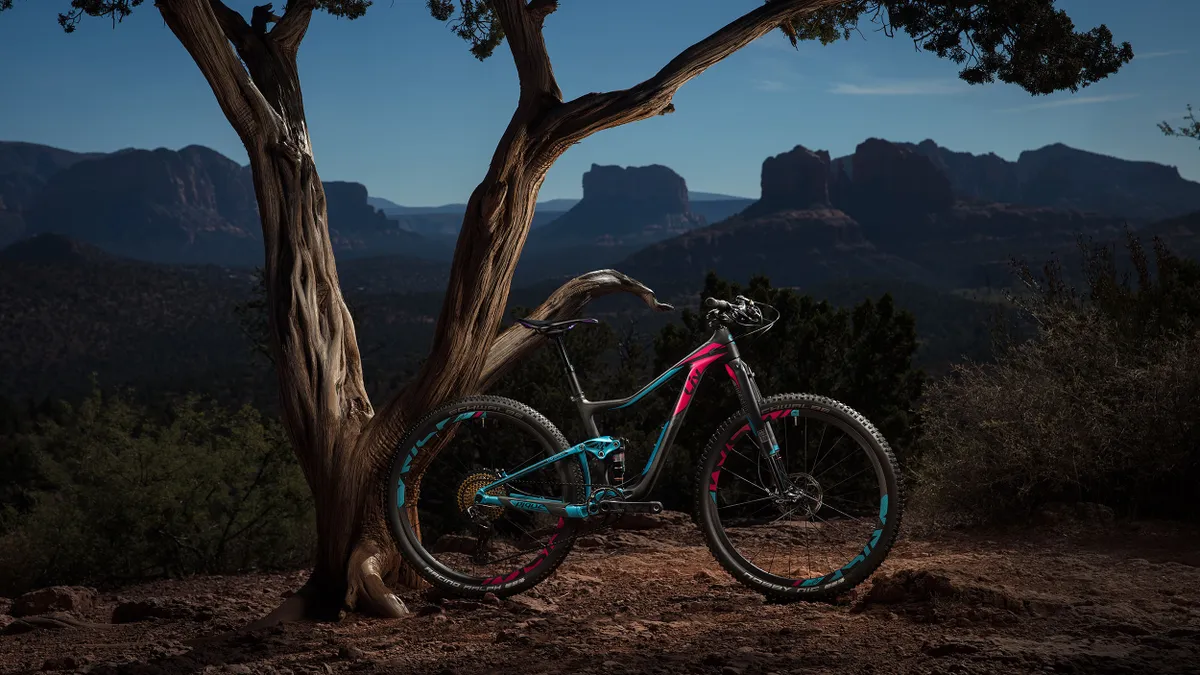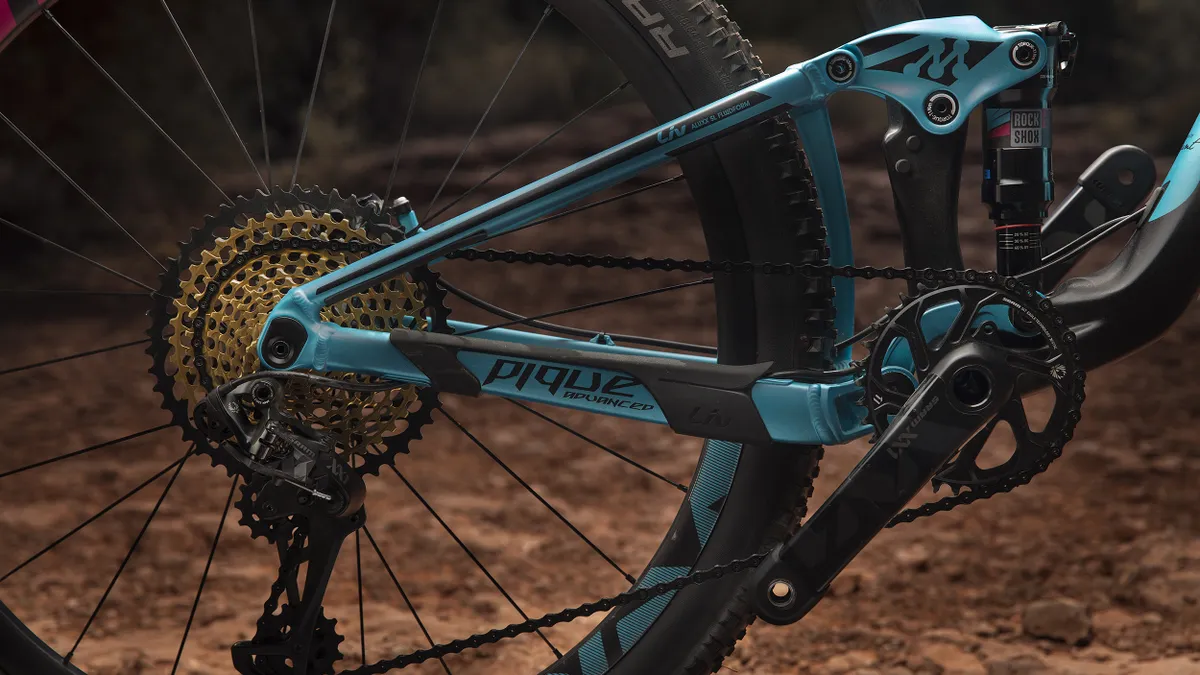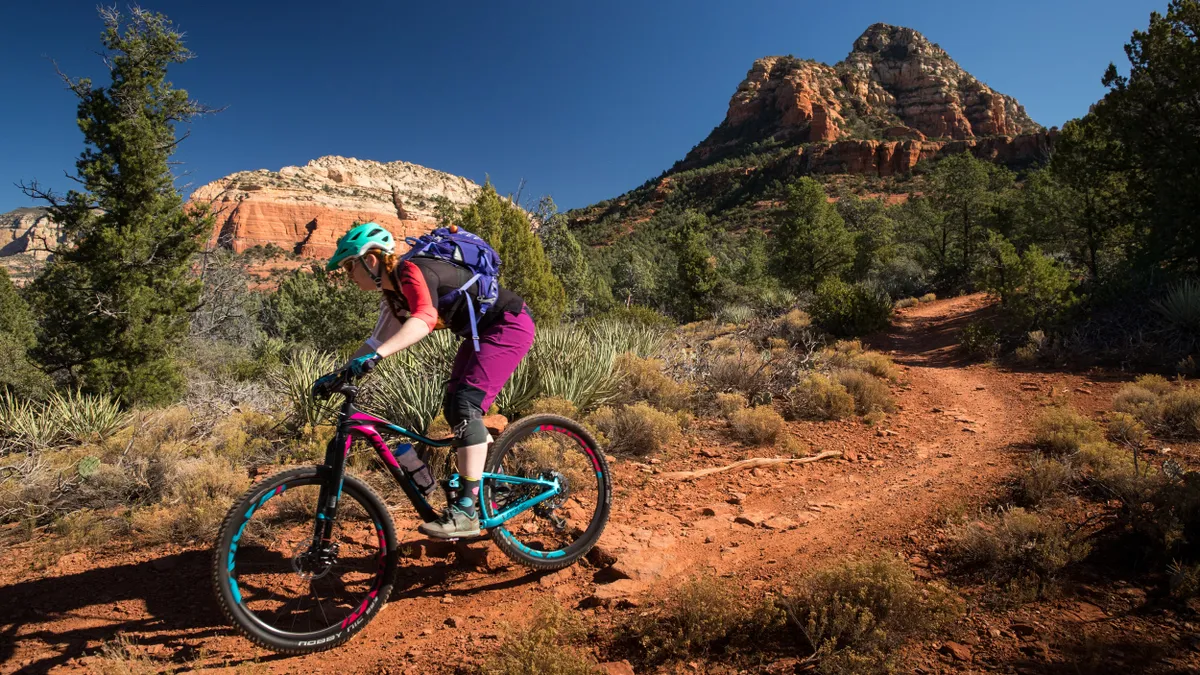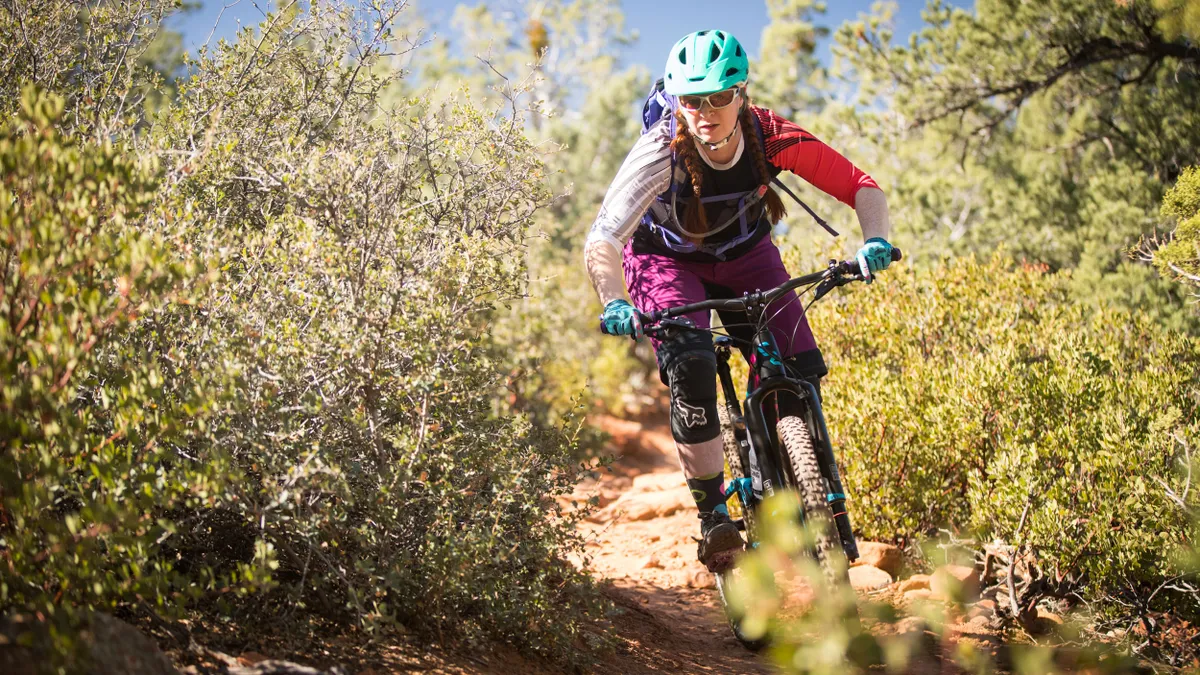The brand new Liv Pique Advanced 0 is a top-of-the-range XC trail bike. Designed for female riders based on body geometry data, it's a 120mm travel full-suspension steed with a carbon frame and 27.5 wheels.
- Liv unveils brand new line of women's mountain bikes
- Best women's mountain bike: how to choose the right bike for you
- Women's Cycling reviews and products on BikeRadar Women
The Pique is an aggressive cross-country bike, part of an increasing trend within XC riding and racing. Stemming from an increase in the technicality of cross-country race courses — which not only combine strenuous technical climbs, but now increasingly feature rock garden descents, drops, and even rhythm sections and drops — these bikes are the result of a drive to create race-worthy bikes that are still efficient climbers and can handle such terrain.
While 29in wheels and hardtails are still popular, there is an increasing number of 27.5" wheeled full-suspension bikes in the cross-country race circuit, and you need to look no further than the winning bike at the Rio Olympics cross-country event to see that the wheel size and suspension are not in themselves a barrier to success in this discipline.

The Pique Advanced 0 is the pinnacle of the Pique range. With more blinging XC kit than you can shake a stick at, it's got top of the range pretty-much everything.
I was pretty excited to get a go on the long anticipated and extremely shiny SRAM Eagle drivetrain, and initial impressions are good
The bike occupies the same cycling niche, as it were, to the Giant Anthem, as Liv and Giant are sibling companies and Giant produces the frames. However, it is very much its own bike, designed from scratch for female riders. Despite a general trend right now for 'women's specific' mountain bikes to be based around a unisex frame and women's specific finishing kit — such as the Specialized Camber Women's and the Juliana bike range's Santa Cruz frames — Liv has taken a completely different approach.
Liv is a company that prides itself on producing capable women's bikes. At the heart of its philosophy is the belief, based on analysis of global body dimension data, that men and women cyclists have sufficient physical differences to warrant different frame geometry.
I rode the Pique over the dry, rocky and dusty trails of Sedona, Arizona, and while it was a great introduction to the capabilities of the bike, I'm keen to take this bike out on familiar trails for longer rides to really get to grips with what it can do and how it performs. In the meantime, here are my initial impressions.
Top whack parts
As you'd expect from a bike that sits at the top of its range, the Pique has some pretty shiny componentry adorning the advanced-grade carbon composite frame with aluminium rear triangle. The RockShox RS1 Solo Air forks with 120mm of travel are paired with a RockShox Deluxe RT3 with Trunnion mount, SRAM XX1 Eagle groupset and SRAM Level Ultimate brakes.
Liv shares the Maestro suspension linkage platform with brother-brand Giant. It's a well established platform that's known for providing good traction and impact absorption, with isolation from pedalling forces inherently in the system. On top of that, the new Trunnion mounted shock — which attaches directly to the shock body rather than a fixture at one end — provides a bigger volume shock in a smaller space within the frame. A larger shock volume means it can be run at a lower pressure, which gives greater small bump sensitivity. So in practice it was a suspension system that happily soaked up the uneven terrain on the red, rock-strewn trails of Sedona.
I found the RS 1 forks too stiff for my liking after the initial recommended set up, but a little trailside fettling with the pressure and rebound brought them to an acceptable level of performance for the combination of rocky climbs and loose sand and gravel. BikeRadar didn't rate them highly as individual components, and based on the initial ride I can't say either way whether I agree or disagree with that verdict, however I will say that the overall ride didn't seem to be adversely affected by their inclusion. I'll reserve judgement until I've spent more time on the bike and them.
The Pique is light: the size small comes in at a reported 10.65kg with a tubeless set up. In practice this took a little getting used to initially because its lightweight nature made it a little skittish on trails at slower speed. However, it also meant that the bike was easily manoeuvrable and when ridden with intent was playful, responsive and fun to handle, and great to throw about.
I was pretty excited to get a go on the long anticipated and extremely shiny SRAM Eagle drivetrain, and initial impressions are good. Shifting is smooth, the movement is quiet — or it is as far as I could make out whipping through rocky ground — and the range is huge. Huge enough, in fact, that I didn't get anywhere near the large or penultimate ring on the terrain I rode in Arizona, so again I'd like to give this a go on something a little more mountainous or with more sustained technical climbs.

High-end finishing kit
As you might expect, the Pique Advanced 0 also has plenty of whistles and bells in its finishing kit too: carbon composite bars and stem, a Giant Contact Switch SL Switch-R Trail dropper seatpost and a SRAM Rise 60 carbon wheelset with Schwalbe Nobby Nic 27.5x2.25 tyres on the front and Racing Ralph 27.5x2.25 EVO on the rear.
Bucking the trend for lower bottom brackets, Liv has opted for raising the BB on the Pique
The cockpit has a sleek, clean look, and the activation of the Giant Contact dropper post was fairly ergonomic and easy to use. I found that the 100mm drop on the saddle combined with the slightly higher seat tube, as a result of the raised bottom bracket (more on that shortly), meant that I couldn't drop the saddle as far out of the way as I would have liked on some descents.
Contact points are a very personal matter, and while I appreciate the women's specific Liv Contact Forward SLR saddle, it's not for me, although other riders at the launch ride found it comfortable.
Raising the bottom bracket
Bucking the trend for lower bottom brackets, Liv has opted for raising the BB on the Pique and, for those interested in longer travel bikes, the 160mm-travel Hail.
It's able to do this partly as result of the space freed up by the new trunnion-mounted shock, which is more compact than previous shock models. So why a higher BB when most other companies are going lower, which has the benefit of lowering the overall centre of gravity of bike and rider, and in turn aids stability?
Liv states that, through the research it's conducted using the Global Body Database, women tend on average to have a lower centre of gravity and drive power from lower in the body than men. Therefore, it concluded, women don't require a bike that has as low a bottom bracket as men in order to achieve the same result.
The company also states that it found many women prefer to be able to drive through pedal strokes on technical terrain and climbs, rather than relying on a fast run-up or ratcheting the pedals. A higher bottom bracket means greater pedal clearance and less chance of catching the pedals on rocks in this context.
In practice, my initial feelings are that the increased pedal clearance does indeed help with technical climbs and pedalling through rough, bouldery terrain, where on other bikes I'd be cautious of catching my pedal and would tend to ratchet my way through. Continuous pedalling feels more efficient, less tiring and more comfortable.
I also didn't notice any particular negative effects from the raised bottom bracket on the few short, rocky descents I encountered in arid Sedona. In fact, despite the relatively steep 70-degree (reported) head angle and overall cross-country purpose of this bike, it descended more like a 140mm or more trail bike than an aggressive cross-country machine. Previous XC-focussed mountain bikes I've tried have felt perched and precarious on descents; not the Pique.
However, as mentioned, I'll reserve full judgement after a load more miles on more familiar terrain.

Liv Pique Advanced 0 availability and pricing
If you want to get your mitts on one of the new Piques, they are available now globally. However, riders in the UK may be disappointed if they are after this particular model because the Pique Advanced 0 isn't available there. Instead, British riders will have to settle for the Pique Advanced 2 (simply labeled the Pique Advanced on the Liv UK website), which shares the same carbon composite frame, but is specced with a SRAM GX 2x11 drivetrain, RockShox Revelation RL Solo Air 120mm forks and RockShox Deluxe RT.
There is also an aluminium version of the Pique available at a lower price point, which has the same geometry, and also the Pique SL with 140mm forks for those looking for a longer travel version for trail riding.
The Liv Pique Advanced 0 retails for $8,975.00 or AU$9,799.00.
Liv Pique Advanced 0 early verdict
A top-of-the-range, aggressive cross-country bike for women.

